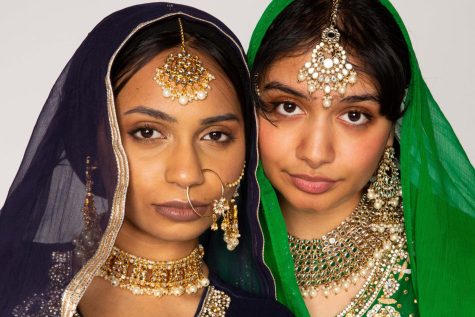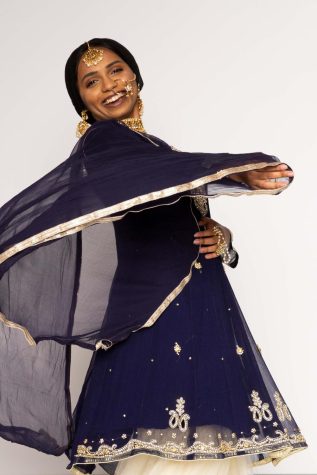Spilling the Chai: What growing up South Asian teaches girls
June 16, 2022

Editor’s note: This article is from the Communication Department’s award-winning Echo magazine.
“Don’t go out in the sun for too long! You’ll get too dark.”
These words from my mother echoed in my 6-year-old head throughout my early adolescence and into my teens. I grew up avoiding the sun at all costs, exercising caution when going out with my friends in the summer and scrubbing viciously at the darker folds in my skin in the shower, thinking that would lift the pigment I was taught to despise.
It didn’t just stop at hating my skin — I started noticing other features I had that my classmates didn’t, and I found myself in this toxic trap of comparing my looks to theirs. I couldn’t help but notice when we changed into our gym uniforms that I was the only girl with hair on her stomach. My 12-year-old self felt like there was something wrong. Growing up in a predominantly white area, I felt singled out, never having seen a girl in school who looked like me.
At 20, I finally un-learned what I’d been taught for years. There was nothing wrong with spending more time outside and getting darker, as I accepted that my body was not just one shade of brown. I found out that body hair was normal. Throughout my years of growing up with social media, I slowly came to the realization that I was not the only one who grew up like this. Many brown girls just like me had similar experiences, where white-washed beauty standards were imposed on them — even from their own families.
Social media influencer Mina Hasan started her TikTok in 2019, by filming vlogs of her life on her trip to Pakistan, as well as the miniseries that caused her to go viral: “Life of a Brown Girl.” Now with 192,100 followers and counting, Hasan curates content that covers skincare, fashion and beauty for South Asian women and girls. She offers advice, addresses topics such as the sexism and double standards in many Desi households and helps embrace their natural and ethnic features, using the handle @recklessmina. (“Desi” refers to people of Indian, Pakistani, or Bangladeshi descent.)
“I wanted to make my niche based off of helping girls who have been in these situations because as I learned from TikTok, I’m not the only one that had these experiences,” Hasan says.
Hasan based many of her videos off questions she received from girls asking for advice on topics from how to convince your parents to let you study abroad to buying specific articles of clothing.
From as early as kindergarten, it had hit Hasan that she did not look like her peers, as she recalls being the only child in her class with a unibrow.
“For the longest time, I just bottled everything up,” Hasan says. “Then I had one really good friend, and both of us were each other’s outlets for the problems we only face that we can’t tell to our white or our Black friends. That was our coping mechanism.”
She thanks her one Pakistani friend in seventh grade, as well as TikTok, for giving her the confidence to speak about embracing Desi girls’ features, such as bigger noses, hyperpigmentation and thick hair, and aims to stop the comparison and idealization of Eurocentric beauty standards.
Kashf Fatima, the vice president of Columbia College Chicago’s Muslim Student Association, says the key reason she became involved with MSA was to find more people like her on campus, especially after transferring from Elmhurst University.
“I realized that I missed seeing other Muslims on campus, because obviously it’s a majority white school, and you want to see your own people — the same people you share food and have shared experiences with,” says Fatima, a junior marketing and digital media major.

MSA aims to unify the Muslim and Desi communities at Columbia and educate others on the culture. Through MSA, Fatima found peers who also struggled with the colorist beauty standards she grew up with.
“Colorism is such a huge issue in our community, especially with bleach cream being promoted, like Fair and Lovely,” Fatima says. “Even within my family I’ve had people tell my mom things like, ‘Don’t let Kashf get any darker than this.’”
Growing up watching Bollywood movies and music videos with glamorized actresses like Aishwarya Rai, Fatima internalized colorism and villainized herself. As a young girl, she compared her own features to Rai’s fair skin and light-colored eyes.
“I was obsessed with that for a while, and that gave me false hopes where it’s like, ‘When I grow older, I definitely want to look like that,’ without knowing how genetics work,” Fatima says.
For Samaher AbuRabah, the struggle of having more hair and bushier brows than her peers had her begging her mother to let her get them waxed.
“I did my eyebrows for the first time when I was literally in fifth grade because they were so humongous,” says the Columbia College Chicago journalism and public relations sophomore.
So, she straightened her thick, curly hair, and if her arms weren’t waxed, she wore sweaters to school. AbuRabah felt a lack of cultural support that went beyond beauty standards. Without an ethnic community or peers to relate to, she struggled to explain to teachers why she had to miss school for religious holidays, such as Eid.
“There wasn’t really an understanding of Muslim holidays,” AbuRabah says. “People weren’t knowledgeable about what being Muslim entails, so I found myself having to explain myself a lot, and as a young kid, you don’t really know your religion a lot.”
At George Mason University, the college has an Indian Student Association that aims to combat similar issues. Offering both a community for the campus’s Desi students as well as an opportunity for non-Desi peers to get educated on the culture, the group is overseen by its faculty advisor and Information Sciences and Technology term professor Kamaljeet Sanghera.
Sanghera explains that ISA provides not only a chance for the students to meet others on campus, but also a way for faculty to get involved and network. The group also provides a space that feels like home for many who are far away from theirs. The group allows her to celebrate her culture and feel connected to her community, which she had not felt before, she says.
ISA Vice President and Treasurer Neha Sehgal says the group aims to bring everyone together, share the culture and offer a chance to help validate the ways members have felt coming from a large, diverse mix of cultural groups.
Sehgal first got involved with the group her freshman year after wanting to find more students like her at the university. Prioritizing diversity, ISA’s board has students from both north and south India as well as Pakistan, and different religious groups.
“The main focus is to bring all of India together because there’s always a lot of division between north and south Indians, and that is pretty prevalent in our school as well,” Sehgal says. “Our goal is to bring everybody together and see us all as one from the same place, rather than the same place but different parts.”
With the rise of Desi influencers sharing their platforms to showcase their features, inclusivity can have a chance to flourish. From South Asian influencers Milan Mathew interlacing culture with fashion to Cas Jerome showing that brown girls can create cosplay characters regardless of how dark their skin is, the future of what is seen as “glamorous” can acknowledge the diversity of beauty. Ending the colorist and unhealthy narrative that one specific look is beautiful once and for all allows a spotlight for people from all different cultures to feel pride and shine.
You can read the entire 2022 issue of Echo, as well as previous issues, on our website.







